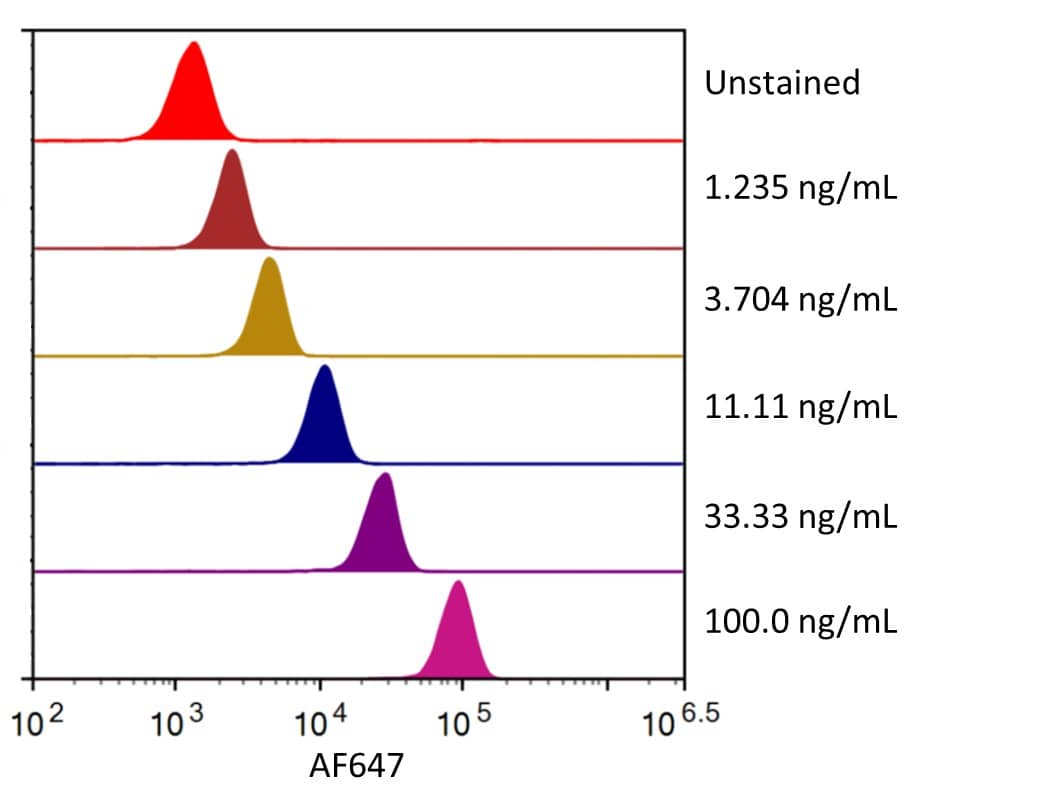Recombinant Human PD-L1/B7-H1 Fc Alexa Fluor® 647 Protein
R&D Systems, part of Bio-Techne | Catalog # AFR156

Key Product Details
Source
Accession #
Structure / Form
Labeled with Alexa Fluor® 647
Excitation Wavelength: 650 nm
Emission Wavelength: 668 nm
Conjugate
Applications
Product Specifications
Source
| Human PD-L1 (Phe19-Thr239) Accession # Q9NZQ7.1 |
DIEGRMD | Human IgG1 (Pro100-Lys330) |
| N-terminus | C-terminus |
Purity
Endotoxin Level
N-terminal Sequence Analysis
Predicted Molecular Mass
SDS-PAGE
Activity
Scientific Data Images for Recombinant Human PD-L1/B7-H1 Fc Alexa Fluor® 647 Protein
Flow cytometry analysis for Recombinant Human PD-L1/B7-H1 Fc Chimera Alexa Fluor® 647 staining on anti-human PD-L1/B7-H1 Monoclonal Antibody conjugated beads.
Streptavidin coated beads conjugated to biotinylated anti-human PD-L1/B7-H1 Monoclonal Antibody were stained with the indicated concentrations of Recombinant Human PD-L1/B7-H1 Fc Chimera Alexa Fluor® 647 (Catalog # AFR156).Recombinant Human PD-L1/B7-H1 Fc Chimera Alexa Fluor® 647 Protein SDS-PAGE.
2 μg/lane of Recombinant Human PD-L1/B7-H1 Fc Chimera Alexa Fluor® 647 Protein (Catalog # AFR156) was resolved with SDS-PAGE under reducing (R) and non-reducing (NR) conditions and visualized by Coomassie® Blue staining, showing bands at 70-75 kDa and 140-150 kDa, respectively.Formulation, Preparation and Storage
AFR156
| Formulation | Supplied as a 0.2 μm filtered solution in PBS and NaCl with BSA as a carrier protein. |
| Shipping | The product is shipped with dry ice or equivalent. Upon receipt, store it immediately at the temperature recommended below. |
| Stability & Storage | Protect from light. Use a manual defrost freezer and avoid repeated freeze-thaw cycles.
|
Background: PD-L1/B7-H1
PD-L1, also known as B7-H1, PDL1, is one of the ligands for PD-1 and plays a critical role in the regulation of T cell immunity (1-6). The PD-1:PD-L1 interaction initiates a negative signaling cascade in T cells leading to inhibition of T cell activation (2, 5, 7, 8). PD-L1 provides a molecular stop signal to the adaptive immune system helping to distinguish between self and foreign antigens. PD-L1 also plays a role in the development of immune tolerance by promoting T cell anergy (1, 5) and enhancing regulatory T cell development (8). In addition, PD-L1 favors the development of anti-inflammatory IL-10 and IL-22 producing dendritic cells (7, 9) and inhibits the development of Th17 cells (8). Many cancers exhibit upregulated PD-L1 protein expression, and several cancers with high levels of PD-L1 have been associated with increased tumor aggressiveness and poor prognosis. Using new therapeutics that block the PD-L1:PD-1 interaction has proven successful in the clinic for many cancer types and has sparked great interest in the field of cancer immunotherapy.
The PD-L1 protein is an approximately 65 kDa transmembrane glycoprotein belonging to the B7 family of immune regulatory molecules (10). Mature human PD-L1 protein consists of a 220 amino acid (aa) extracellular domain (ECD) with two immunoglobulin-like domains, a 21 aa transmembrane segment, and a 31 aa cytoplasmic domain (11). Within the ECD, human PD-L1 shares 73% and 74% aa sequence identity with mouse and rat B7-H1, respectively. Alternative splicing generates additional isoforms that either lack the first Ig-like domain or are truncated within the second Ig-like domain (12). PD-L1 is expressed on inflammatory-activated immune cells including macrophages, T cells, and B cells (10, 13, 14, 16) keratinocytes (9, 11), endothelial and intestinal epithelial cells (2, 9), as well as a variety of carcinomas and melanoma (12, 16).
References
- Tsushima, F. et al. (2007) Blood 110:180.
- Mazanet, M.M. and C.C.W. Hughes (2002) J. Immunol. 169:3581.
- Azuma, T. et al. (2008) Blood 111:3635.
- Butte, M.J. et al. (2008) Mol. Immunol. 45:3567.
- Park, J.-J. et al. (2010) Blood 116:1291.
- Ritprajak, P. et al. (2010) J. Immunol. 184:4918.
- Chen, L. et al. (2007) J. Immunol. 178:6634.
- Herold, M. et al. (2015) J. Immunol. 195:3584.
- Scandiuzzi, L. et al. (2014) Cell Rep. 6:625.
- Ceeraz, S. et al. (2013) Trends Immunol. 34:556.
- Dong, H. et al. (1999) Nat. Med. 5:1365.
- Frigola, X. et al. (2011) Clin. Cancer Res. 17:1915.
- Tamura, H. et al. (2001) Blood 97:1809.
- Kuang, D.-M. et al. (2014) J. Clin. Invest. 124:4657.
- Cao, Y. et al. (2010) Cancer Res. 71:1235.
- Dong, H. et al. (2002) Nat. Med. 8:793.
Long Name
Alternate Names
Entrez Gene IDs
Gene Symbol
UniProt
Additional PD-L1/B7-H1 Products
Product Documents for Recombinant Human PD-L1/B7-H1 Fc Alexa Fluor® 647 Protein
Product Specific Notices for Recombinant Human PD-L1/B7-H1 Fc Alexa Fluor® 647 Protein
This product is provided under an agreement between Life Technologies Corporation and R&D Systems, Inc, and the manufacture, use, sale or import of this product is subject to one or more US patents and corresponding non-US equivalents, owned by Life Technologies Corporation and its affiliates. The purchase of this product conveys to the buyer the non-transferable right to use the purchased amount of the product and components of the product only in research conducted by the buyer (whether the buyer is an academic or for-profit entity). The sale of this product is expressly conditioned on the buyer not using the product or its components (1) in manufacturing; (2) to provide a service, information, or data to an unaffiliated third party for payment; (3) for therapeutic, diagnostic or prophylactic purposes; (4) to resell, sell, or otherwise transfer this product or its components to any third party, or for any other commercial purpose. Life Technologies Corporation will not assert a claim against the buyer of the infringement of the above patents based on the manufacture, use or sale of a commercial product developed in research by the buyer in which this product or its components was employed, provided that neither this product nor any of its components was used in the manufacture of such product. For information on purchasing a license to this product for purposes other than research, contact Life Technologies Corporation, Cell Analysis Business Unit, Business Development, 29851 Willow Creek Road, Eugene, OR 97402, Tel: (541) 465-8300. Fax: (541) 335-0354.
For research use only

